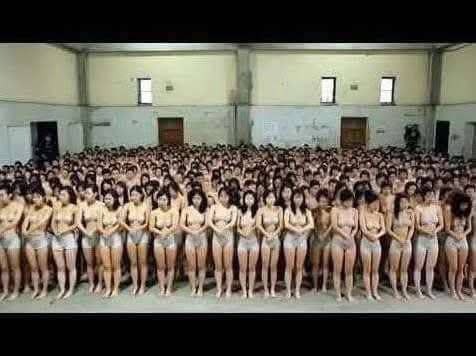When it comes to the world’s most unusual or extreme traditions, North Korea almost always comes up. Known for its colossal, perfectly synchronized military parades, tightly controlled media, and a level of secrecy few outsiders can penetrate, the Democratic People’s Republic of Korea has long been seen as both mysterious and intimidating. Yet among its many strict and surreal practices, one stands out as particularly shocking: large-scale, state-organized body inspections of young women.
A photograph that recently went viral online provides a rare glimpse into this unsettling ritual. In the image, rows of young women stand silently in a vast hall, all wearing nearly identical uniforms, their postures straight, their faces carefully neutral, as if awaiting instructions. To an untrained eye, it might look like a dance audition, a military drill, or a scene straight out of a dystopian movie. But for those familiar with North Korean society, it reveals a darker truth: the regime’s intense focus on controlling not only minds, but bodies.
Defectors and experts have explained the purpose behind such gatherings. Though never publicly acknowledged, these inspections usually target women in their late teens or early twenties—often college students or applicants for prestigious positions in state institutions. The goals vary. Some are to assess fitness for military or labor assignments. Others, particularly linked to grand national spectacles like the Mass Games, aim to select “ideal” physiques for public performances.
The deeper question is why the regime devotes so much energy to evaluating appearance. To outsiders, it may seem like an authoritarian beauty pageant. But in North Korea, physical uniformity is more than aesthetic preference—it is a tool of ideological control.
Since its founding, the state has built power around projecting unity, strength, and perfection. Every parade, concert, or performance is meticulously orchestrated to erase individuality, replacing it with collective identity. Citizens become interchangeable components of a larger machine, moving in harmony under constant surveillance. In this context, a slim, symmetrical body is not merely attractive—it is a symbol of loyalty, obedience, and belonging.
This obsession also connects to North Korea’s rigid social hierarchy, known as “songbun.” Songbun assigns citizens status based on family background, political reliability, and social behavior. Those with “undesirable” lineage or history face lifelong discrimination, barred from top jobs, universities, and decent housing. Within this framework, physical appearance itself becomes political. Meeting the unspoken standards—healthy, fit, disciplined—can open doors, while failing to do so may consign someone to obscurity or harsh labor.
For the young women subjected to these inspections, the stakes are immense. Success can lead to elite educational opportunities, prestigious cultural roles, or the rare honor of performing before Kim Jong Un. Failure can mean menial labor or permanent exclusion from public-facing positions.
This is not simply about beauty or fitness. In North Korea, the body is politicized. The state controls how citizens eat, dress, and move, framing conformity as a patriotic duty. Individual choice and personal identity are stripped away until even one’s physical form reflects the regime’s authority.
The viral image resonated globally because it captures a reality most people cannot imagine: being physically scrutinized and judged by the government. For many North Koreans, especially women, this is ordinary life. The photograph conveys not only their silence, but also the weight of that silence—the understanding that nonconformity can close doors or draw suspicion.
While similar pressures exist elsewhere—societies worldwide often link women’s appearance to value—North Korea is unique in the sheer force behind the enforcement. Cultural expectations are codified into state-mandated rituals.
Ultimately, these regimented inspections are not about health or fitness—they are about discipline. They remind every young woman in those long lines that her body belongs not just to her, but to the state, its propaganda, and the idealized image it projects both internally and externally.
The photograph, unsettling as it is, offers a rare glimpse into this reality. It underscores a chilling truth: authoritarian control does not stop at thought or speech. In North Korea, it reaches into the most intimate space imaginable—the body itself.
For those young women, standing silently in that hall, the reality is suffocating: in a society where even a smile or posture can signal loyalty or defiance, the body is never merely a body. It is a stage for the regime’s performance of power, unity, and obedience.
